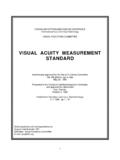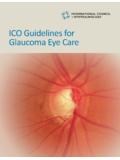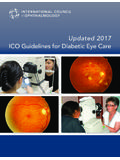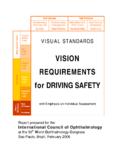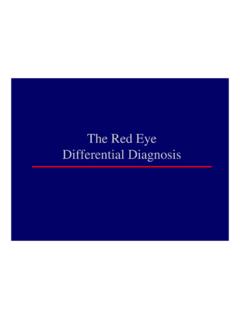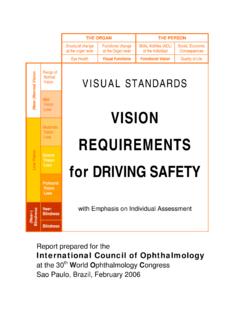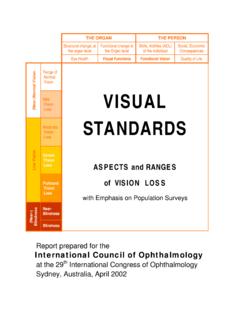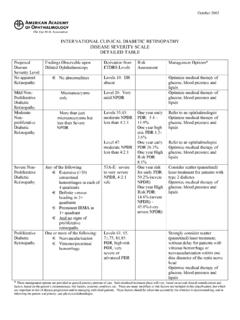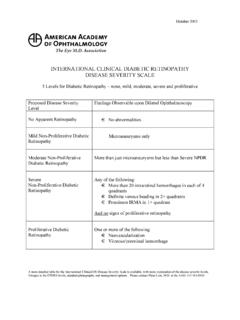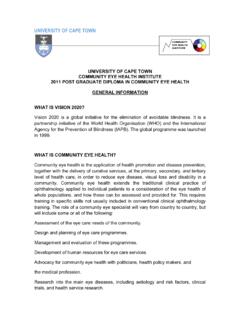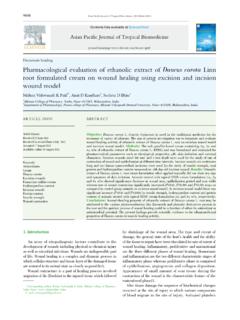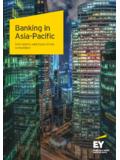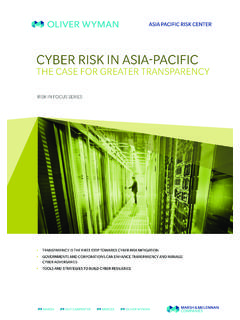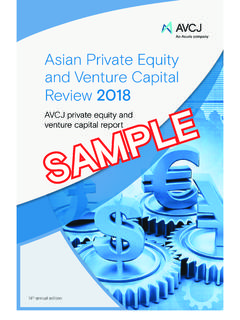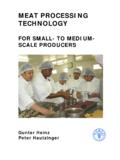Transcription of ASIA PACIFIC Glaucoma Guidelines
1 ASIA PACIFIC . Glaucoma Guidelines MEMBERS OF THE WORKING PARTY. CO-CHAIRS. Tin Aung, Singapore Jonathan Crowston, Australia Executive Director, Singapore Eye Research Institute; Deputy Medical Director, Centre for Eye Research Australia Director (Research), Singapore National Eye Centre; Head of Ophthalmology, University of Melbourne Senior Consultant and Head, Glaucoma Dept, Singapore National Eye Centre;. Professor, Dept of Ophthalmology, Yong Loo Lin School of Medicine, National University of Singapore. MEMBERS. Henry Shen-Lih Chen, Taiwan Rainier Victor A. Covar, Philippines Visiting Staff and Assistant Professor, Clinical Associate Professor, University of Glaucoma Service, Department of the Philippines-Philippine General Hospital Ophthalmology, Chang Gung Memorial Department of Ophthalmology and Visual Hospital , Linkou, Taiwan Sciences Consultant staff, The Medical City Assistant Professor, Ophthalmology, Chang Consultant staff, St.
2 Luke's Medical Center Eye Gung Memorial Hospital , Chang Gung Medical Institute, Manila, Philippines College , Chnag Gung University, Taiwan Executive Secretary, Taiwan Glaucoma Society Ronnie George, India Seok Hwan Kim, Korea Director Research, Vision Research Department of Ophthalmology, Seoul Foundation, Chennai National University, Boramae Medical Center, Senior Consultant, Glaucoma Services, Seoul, Korea Sankara Nethralaya, Chennai Professor, Elite School of Optometry, Chennai Naris Kitnarong, Thailand Dexter Leung, Hong Kong; China Associate professor, Departement of Honorary Consultant & Specialist Ophthalmology, Faculty of Medicine Siriraj in Ophthalmology, Department of Hospital, Mahidol University, Bangkok, Ophthalmology, Hong Kong Sanatorium &. Thailand Hospital Honorary Clinical Associate Professor, Department of Ophthalmology & Visual Sciences, The Chinese University of Hong ASIA PACIFIC Glaucoma Guidelines .
3 Kong President, Hong Kong Ophthalmological Society Member, Associate Advisory Board, International Society of Glaucoma Surgery ASIA PACIFIC Glaucoma Guidelines . Yuanbo Liang, China Toru Nakazawa, Japan Professor and Director in the Clinical and Tohoku University Graduate School of Epidemiological Eye Research Center, Medicine Department of Ophthalmology. Wenzhou Medical University Shamira Perera, Singapore Sushil Vasudevan, Malaysia Senior Consultant Ophthalmologist, Assoc Prof, Consultant Ophthalmologist, Glaucoma Service, Singapore National Eye Faculty of Medicine, Universiti Teknologi Centre MARA and Fellow of the Institute for Co Head, Bioengineering and Devices, Pathology, Laboratory & Forensic Medicine Singapore Eye Research Institute (I-PerForm), Jalan Hospital, Sg Buloh, Adj Assoc Prof Duke- NUS Graduate Medical Selangor, Malaysia. School Andrew White, Australia Renyi Wu, China Chair, Glaucoma Australia Expert Advisory Professor of Ophthalmology, Xiamen PanelChair, Agency for Clinical Innovation: University, China.
4 C-Eye-C ProjectConsultant Ophthalmologist, Head of Glaucoma Department, Medical Westmead Hospital Director of Shanghai Peace Eye Hospital, Director, Community Eye Care Centre, Huaxia Eye Hospital Group, China Western SydneyClinical Senior Lecturer, Member of China Glaucoma Society Discipline of Ophthalmology and Eye Health, Sydney Medical School Foundation Fellow Westmead Institute | Sydney Medical School . WesternSave Sight Institute | Sydney Medical School Central University of Sydney CONTRIBUTOR. Nafees Baig, Hong Kong, China Chinese University of Hong Kong; Hong Kong Eye Hospital, Hong Kong, China Members of the Working Party MEMBERS OF THE REVIEW COMMITTEE. Manuel Agulto, Philippines Anton Hommer, Austria Makoto Aihara, Japan Jost Jonas, Germany Norman Aquino, Philippines Ramasamy Krishnadas, India Makoto Araie, Japan Chris Leung, Hong Kong Sanjay Asrani, USA Catherine Liu, Taiwan Stephen Best, New Zealand Keith Martin, UK.
5 Eytan Blumenthal, Israel Fred Mikelberg, Canada Paul Chew, Singapore Vinay Nangia, India Vital Costa, Brazil Rajul Parikh, India Guy D'Mellow, Australia KiHo Park, Korea Tanuj Dada, India Harry Quigley, USA. SK Fang, Malaysia Rengappa Ramakrishnan, India Imalka Fonseka, Sri Lanka Robert Ritch, USA. Paul Foster, UK Prin RojanaPongpun, Thailand Scott Fraser, UK Kuldev Singh, USA. David Friedman, USA Ikke Sumantri, Indonesia Chris Girkin, USA Hidenobu Tanihara, Japan Ivan Goldberg, Australia Clement Tham, Hong Kong David Greenfield, USA Carlo Traverso, Italy Franz Grehn, Germany Lingam Vijaya, India/Singapore Neeru Gupta, Canada Mark Walland, Australia Paul Healey, Australia Ningli Wang, China Anders Heijl, Sweden Tetsuya Yamamoto, Japan Ching-Lin Ho, Singapore ASIA PACIFIC Glaucoma Guidelines . ASIA PACIFIC Glaucoma Guidelines . ACKNOWLEDGMENT. The following companies supported the development of the Guidelines through unrestricted education grants Platinum Alcon Santen Gold Pfizer Silver Allergan ALLERGAN.
6 Bronze Ellex Heidelberg Engineering TopCon Supporter Oculus Zeiss Acknowledgment ABOUT APGS. The Asia- PACIFIC Glaucoma Society (APGS) was established to facilitate interaction between Glaucoma specialists in the region, to encourage collaborative research and service projects, to increase the opportunities for exchange of skills and knowledge in this rapidly advancing field, and to assist our comprehensive ophthalmological colleagues and other eye care workers (whether medically trained or not) to be up to date with advances in all aspects of Glaucoma diagnosis and management. EXECUTIVE COMMITTEE. President Secretary Makoto Araie, Japan Seng Kheong Fang, Malaysia Vice President Treasurer Prin Rojanapongpun, Thailand Paul Healey, Australia Vice President Immediate Past President Clement Tham, Hong Kong Ivan Goldberg, Australia BOARD. Astrianda Suryono, Indonesia Manuel Agulto, Philippines Catherine Liu, Taiwan Nazrul Islam, Bangladesh Clement Tham, Hong Kong Ningli Wang, China Da Wen Lu, Taiwan Norman Aquino, Philippines Ge Jian, China Paul Chew TK, Singapore Ho Ching Lin, Singapore Paul Healey, Australia Ikke Sumantri, Indonesia Prin Rojanapongpun, Thailand Ivan Goldberg, Australia Ramanjit Sihota, India Jamyanjav Baashankhuu, Mongolia Seng Kheong Fang, Malaysia Ki Ho Park, Korea Tetsuya Yamamoto, Japan Makoto Araie, Japan Tin Aung, Singapore APGS EXECUTIVE OFFICE.
7 82 Harris Street Pyrmont NSW 2009. Australia Tel: +61 2 9213 4090. Email: Website: ASIA PACIFIC Glaucoma Guidelines . ASIA PACIFIC Glaucoma Guidelines . TABLE OF CONTENTS. Members of the Working Party ii Members of the Review Committee iv Acknowledgment v About APGS vi Introduction 1. Epidemiology of Glaucoma in Asia 2. Section 1 Assessment Patient Assessment 7. Risk Categories and Treatment Targets 25. Section 2 Treatment Initiation of Treatment 33. Medical Treatment 36. Laser Treatment 42. Surgery 54. Section 3 Follow-Up Follow-Up 65. Screening 73. Appendices Appendices 83. Definition of Terms 118. Abbreviations 120. References 123. Table of Contents APPENDICES. 1. Medical Treatment Of Childhood Glaucoma 83. 2. Treatment in Pregnancy and Lactation 84. 3. Systemic Medications That May Induce Angle Closure 86. 4. How To Test Calibration of a Goldmann Tonometer 87. 5. Tonometry Mires 88. 6A. Gonioscopy 89. 6B. Goniogram/Gonioscopic Chart 90.
8 6C. Modified Van Herick Grading 91. 6D. Ultrasoundbiomicroscopy 92. 6E. Anterior Segment Optical Coherence Tomography (As-Oct) 93. 6F. Corneal Wedge Diagram 94. 7A. How To Optimise Patient Performance in Subjectiveperimetry 95. 7B. Common Artifacts for Visual Field Measurements 96. 8. Secondary Glaucomas Principles of Management 97. 9. Angle Closure Mechanisms 98. 10. Side Effects oF Glaucoma Medications 99. 11A. Laser Trabeculoplasty 102. 11B. Contact Trans-Scleral Diode Laser 103. 12. Glaucomatous Optic Neuropathy 104. 13A. Imaging Devices 106. 13B. Field Progression 111. 14. The Glaucoma Quality of Life-15 Questionnaire 117. ASIA PACIFIC Glaucoma Guidelines . viii . ASIA PACIFIC Glaucoma Guidelines . INTRODUCTION. The Asia PACIFIC Glaucoma Guidelines originated in 2003 and have been distributed widely across the region in both print and CD-ROM format. These Guidelines were created to raise awareness and update clinical knowledge about Glaucoma and to provide a rational basis for Glaucoma diagnosis and cost effective management that is appropriate for the Asia- PACIFIC Region.
9 Devising best-practice methodologies for the Asia PACIFIC region continues to represent a unique challenge, given the diverse health care service systems and the wide range of available resources. The working groups have tried to be sensitive to the wide variations in human, structural, and equipment resources available throughout the Asia PACIFIC region, as well as the ethnic diversity of the local communities. We appreciate that while a guideline may be suitable in one country or location, it may not be ideal in another. Wherever possible we have strived to define an optimal standard of care that is deserved by all our patients and communities. Glaucoma subspecialists in the APGG Working Party and Review Group have collaborated closely and widely to compile the information and recommendations within the Guidelines . These will assist comprehensive ophthalmologists, general health care and eye care professionals, and health care policy makers to deliver effective Glaucoma management to their communities.
10 We have relied on published evidence, wherever possible, and on expert consensus when definitive evidence was not available to ensure that the 3rd Edition of the Guidelines are as up-to-date as possible. We have also benefitted from generous educational grants from industry: see Acknowledgements on page v. This sponsorship permitted the Working Party to meet face-to-face and cover costs of publication and distribution of the 3rd Edition of the APGG. The easy-to-read format of the 1st Edition of the APGG has been retained; each section answers questions of Why?', What?', When?', and How?'. As with all treatment Guidelines , this publication is not a prescription for automated care. By adapting the Guidelines to the patient before you, bearing in mind individual needs, and the socio-economic environment and medical facilities available, plus your own experience, we hope the 3rd Edition of the APGG helps you to achieve the hallmark of excellent care.
